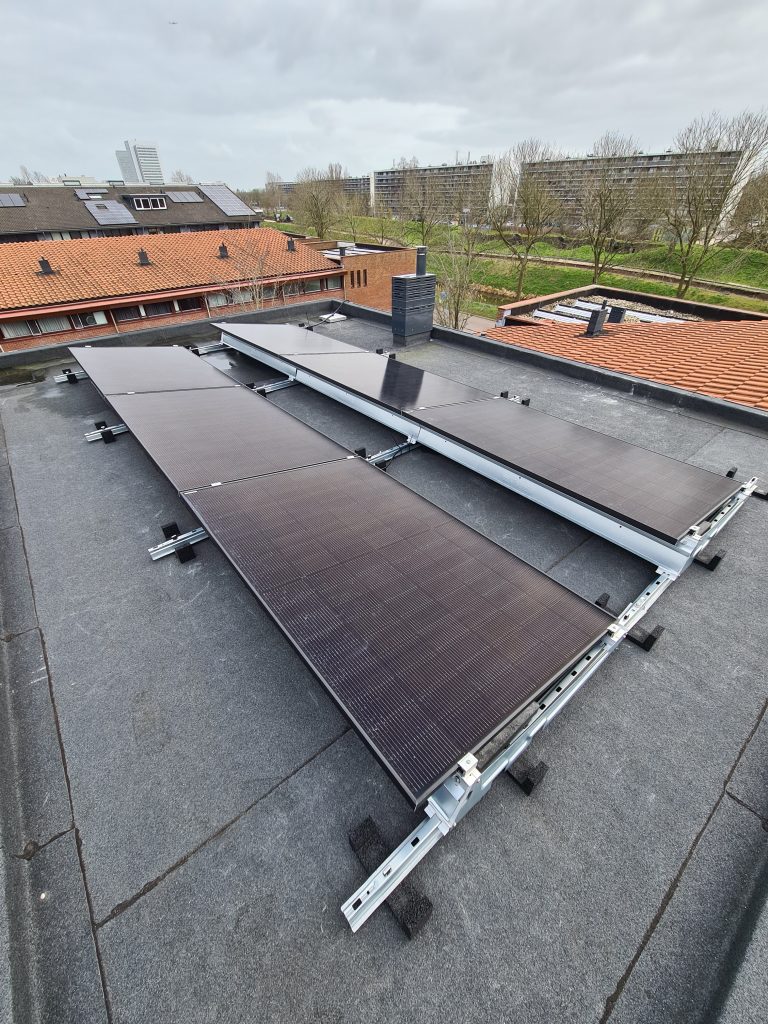
The use of ballast, such as tiles or stones, when installing solar panels on a flat roof is a common method of ensuring the stability and safety of the solar system. Although new techniques have been developed to install solar panels without ballast, there are still situations where the use of ballast is preferable. In this blog post, we will discuss the benefits of using it with flat roof solar panels and why it may be a better choice in certain cases.
Stability and safety
One of the main advantages of its use is the increased stability of the solar system. The extra weight of the ballast ensures that the solar panels remain firmly in place, even in strong gusts of wind. This is especially important in areas with windy conditions or for installations on higher buildings.
Structural load
Using reinforcement distributes the weight of the solar panels and mounting system evenly over the roof surface. This reduces structural loads, reducing the likelihood of roof damage and other structural problems. This can be especially relevant with older roofs or roofs with limited load capacity.
Flexibility in assembly
The use of attenuation provides more flexibility when installing solar panels on the roof. By placing the ballast in strategic locations, panels can be placed in areas with obstacles such as skylights, ventilation pipes or other roof installations. This allows the maximum potential of the roof to be utilized and no space is wasted.
Limited risk of roof leakage
Properly placing weighting on the roof can help prevent potential roof leaks. Ballast acts as an additional protective layer that protects the solar panels from water infiltration. This is especially important on flat roofs where water accumulation can occur.
Simplified installation
The use of attenuation can simplify the installation of solar panels. Compared to ballast-free systems, there are fewer attachment points and less accuracy is required in order to correctly position the panels. This can reduce installation time and improve overall process efficiency.
Durability and weather resistance
Reinforcement provides additional durability and weather resistance for the solar system. It acts as a protective layer against extreme weather conditions, such as strong winds, hail or snowfall. This extends the life of the solar panels and reduces the risk of damage.
Maintainability
The use of ballast facilitates the maintenance of solar panels. By using ballast, the panels can be easily removed or moved for inspection, cleaning or any repairs. This simplifies the maintenance process and minimizes the time and cost required for maintenance work.
Streamlined system
In addition, the use of ballast with solar panels on a flat roof can also offer aesthetic benefits. Strategically placing ballast can help create a uniform and streamlined appearance of the solar system. This is especially important when the flat roof is visible from the first floor or neighbouring buildings. By carefully choosing and positioning the ballast, the solar system can become a visually appealing element that complements the building’s architecture. This helps maintain the aesthetics of the building and contributes to a positive perception of solar energy as a modern and environmentally friendly energy solution.
Conclusion
Although there are new techniques for installing solar panels without ballast on a flat roof, the use of ballast still offers significant advantages. The stability, safety, reduced structural load, flexibility in installation, reduced risk of roof leakage and simplified installation make the use of ballast an attractive option in certain situations. However, it is important to conduct a thorough roof analysis and follow local regulations and recommendations to ensure that the ballast is used properly. Balancing the roof with ballast can be a wise choice to achieve a safe and durable solar system on a flat roof. It can also increase peace of mind, knowing that the solar system is well anchored and more resistant to extreme weather conditions. It offers benefits not only in the short term, but also in the long term through the extended life and better performance of the solar system.








